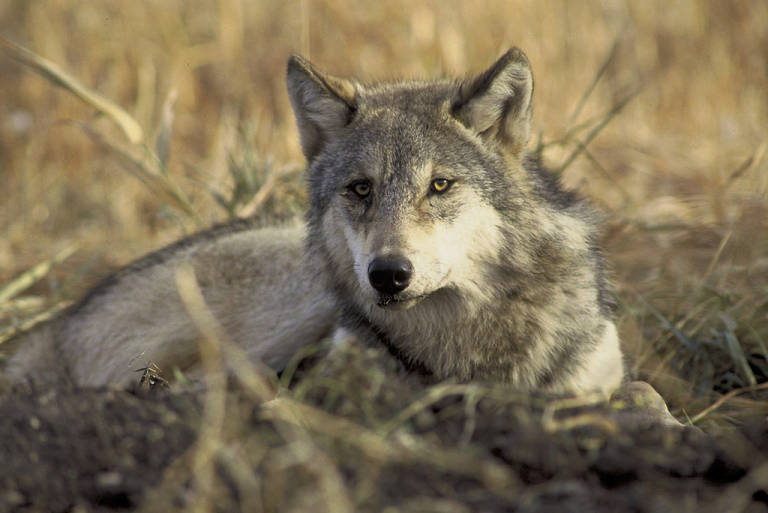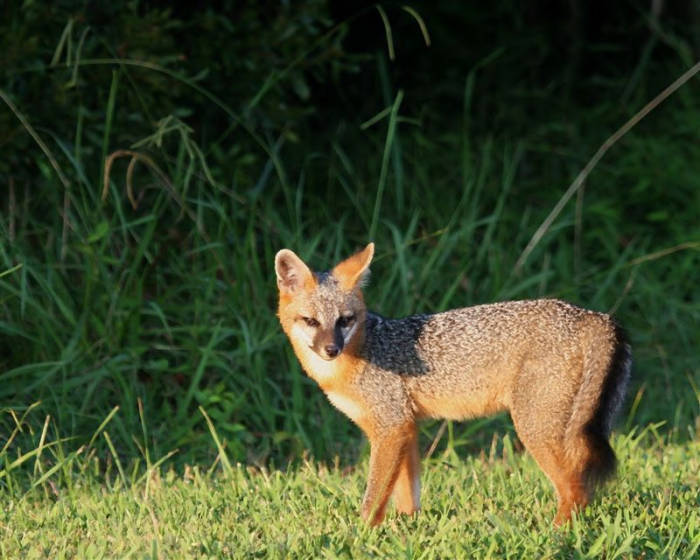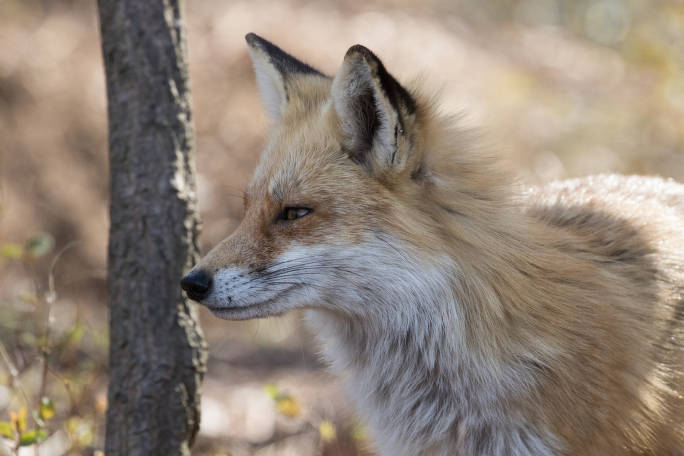
Dogs of the North Country
By John Davis - Adirondack Council Rewilding Advocate
Thursday, Dec. 15, 2022
Native Canines of Northern New York and New England
Even before the science of conservation biology matured, the Adirondack Council bravely went on record supporting the return of wolves and cougars to Adirondack Park. Conservation biology has since confirmed the great ecological importance of top carnivores, and the need of these wide-ranging animals for big interconnected core reserves. Adirondack Council, in our 2020 Vision series, released in 1988, called for expanding and completing the Forest Preserve system in Adirondack Park and welcoming home our missing carnivores. We proposed a half million acre wilderness in western Adirondack Park, which then we called the proposed Bob Marshall Great Wilderness and now usually call the Oswegatchie Wildands Complex, which would afford ample habitat, together with the rest of the Park and connected wildlands beyond, for all wild carnivores, including all our native dogs and cats.
Heroic Dispersers
Often, wild animals themselves tell us where we most need to reconnect and protect wildlife habitats. Among recent publicized mammal dispersal events is a female moose, named Alice by her followers, who ventured in 1998 from central Adirondack Park northwest along the Adirondack to Algonquin (A2A) wildway and lived the remainder of her life in Ontario’s Algonquin Park. Then in 2010, a young puma (cougar, mountain lion, panther – all the same big cat) who began life in South Dakota’s Black Hills journeyed east across Minnesota, Michigan’s Upper Peninsula, and southern Ontario, then he, too, probably followed (in the opposite direction of Alice) the A2A wildlife corridor into our region. The great cat, later named Walker, was seen near Lake George, but kept moving, because he could not find a mate. Tragically, he was killed by a speeding car on a highway in Connecticut, still looking for love in all the wild places.
 Gray wolf, photo courtesy of US Fish and Wildlife Service
Gray wolf, photo courtesy of US Fish and Wildlife Service
Wolves have likely dispersed back into our region from Canada multiple times. Late last year, Northeast Ecological Recovery Society contacted a hunter who shared photos on Facebook of an 85-pound male canid that he had shot in central New York and assumed was a big coyote. The Society realized that a canid so big would probably be a wolf, not a coyote, or at least have a strong admixture of wolf in his genes. Thankfully, the hunter agreed to share tissue samples from the carcass.
The Society sent the tissue samples to a genetics lab. The results showed that the large canid was almost entirely Wolf, genetically as well as physiologically.
Initially, New York’s Department of Environmental Conservation disputed the genetic findings and denied the reality of a wolf in New York, but after considerable pressure from an emerging network of wildlife advocacy groups, including the afore-mentioned Society, Adirondack Council, The Rewilding Institute, Project Coyote, Protect the Adirondacks, Adirondack Wild, Center for Biological Diversity, and Maine Wolf Coalition, DEC conceded it was a wolf in New York. DEC has since issued a caution to hunters to be careful not to mistake a wolf for a coyote, and to report any large canids shot or trapped. DEC has also informally agreed with the emerging Northeast Wolf Task Force that the state of New York must keep the wolf on the state endangered species list.
Solid confirmation of a Wolf in New York has major ramifications. One is that the A2A axis likely is still facilitating occasional dispersal of wide-ranging animals, as it did for Alice the Moose 25 years ago, and needs fuller protection. A second is that the open killing season on coyotes is ecologically, as well as ethically, wrong. Successful wolf recolonization is highly unlikely until all large wild canids have at least partial protection. A third is that we residents of New York and New England should get to know our wild canine neighbors, cousins to our beloved dogs.
Canine Confusion
The young man who mistook a wolf for a coyote was making a common error. Wolves and coyotes look quite similar and can interbreed. They both belong to the genus Canis, whereas our other two native canines are in different genera. Scientists’ name for the Red Fox is Vulpes fulva (or Vulpes vulpes, for those who consider the North American Red Fox to be the same species as the European Red Fox); and the scientific name for the Gray Fox is Urocyon cinereoargenteus. Red foxes and gray foxes are also easy to mistake for one another. Both, despite their common names, can have pelage of different hues.
 Gray fox, photo courtesy of US Fish and Wildlfe Service
Gray fox, photo courtesy of US Fish and Wildlfe Service
Gray foxes are the more arboreal of our two native foxes. Indeed, gray foxes can climb trees and sometimes den in trees. They can often be distinguished from red foxes, if not by color, by their shorter legs and thinner fur. Red foxes are the more likely to be seen in fields, where they often pounce on rodents.
Red and gray foxes are too genetically different to interbreed successfully, but wolves and coyotes have interbred. The apparent origin of our large Eastern Coyotes is that they colonized eastward across southern Canada from their original homes in the Great Plains and westward as wolves were eradicated. Moving across southern Canada, coyotes were occasionally chosen as mates by the more dominant but scarcer gray wolves.
 Red fox, photo courtesy of US Fish and Wildlife Service
Red fox, photo courtesy of US Fish and Wildlife Service
The genetic aspects of the wolf/coyote story are still not entirely clear, however. Genetic research confirms past interbreeding between wolves and coyotes, but it remains unclear just what wolf was originally in the Adirondacks – likely gray wolf, but possibly red wolf, or maybe both, or maybe something in between … No wonder some biologists facetiously use the term Canis soupus for large native dogs of our region.
Both red and gray foxes are masterful hunters of rodents, making them beneficial to limiting the spread of Lyme and other tick-borne diseases. Among the many unfortunate consequences of the elimination of wolves from the eastern United States is that has allowed coyotes to proliferate which in turn has depressed fox populations. Coyotes are good hunters of rodents, but foxes are better. Along with strong ecological, ethical, aesthetic, and spiritual arguments for welcoming home our missing top carnivores, particularly wolves and puma, there are public health reasons for doing so.
Coexisting with the Cousins of Humans’ Best Friend
Our beloved dogs, of course, are in the same family as wolves, coyotes, and foxes. Indeed, domestic dogs, Canis familiaris, are closely enough related to both wolves and coyotes that interbreeding does occasionally happen, when a dog goes feral. Our big eastern coyotes can be nearly a third wolf in genetic material but also may have small vestiges of the domestic dog genome.
Canis soupus - domestic mutt
In terms of threats to people, domestic dogs are easily the most dangerous of the dog family. Wolves essentially never attack people, rarely attack livestock. Domestic dogs kill about twenty Americans a year. Foxes may occasionally take poultry, but make our lives safer by eating the rodents that are vectors of tick-borne bacteria. Coyotes occasionally take calves or sheep, but play critical roles in our ecosystems, and also eat many rodents. To encourage coexistence with our native carnivores, we consumers should support compensation programs for farmers who lose livestock to native predators. A more balanced Adirondack Park would see gray and/or red wolves, fewer coyotes (whom wolves will displace), and more foxes. Coexisting with these wild dogs can be as easy as having a family dog, and our lives will be safer and more aesthetically rewarding for it.
Wolf, red fox, and gray fox photos courtesy of the US Fish and Wildlife Service.

John Davis returned to the Adirondack Council staff in 2021 as its Rewilding Advocate. He is also the Director of The Rewilding Institute. In these complementary positions, John promotes the protection and restoration of wilderness and wildlife throughout Adirondack Park and beyond. John has also worked as a land steward with Adirondack Land Trust, Eddy Foundation, and Northeast Wilderness Trust, especially in Split Rock Wildway – a wildlife corridor linking Lake Champlain with the High Peaks. John explores wild places by hiking, paddling, and cross-country skiing. His long conservation treks are described in his book Big, Wild, and Connected: Scouting an Eastern Wildway from Florida to Quebec and in the TrekWest film Born to Rewild. John lives with his wife Denise Wilson-Davis in Essex, NY.




